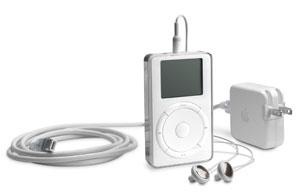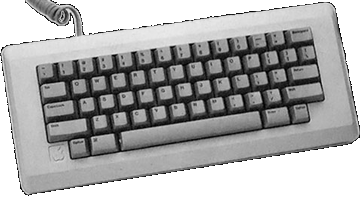iPod

Essentials
Family: iPod
Codename: Dulcimer
Minimum OS: iPod OS 1.0
Maximum OS: iPod OS 1.5
Introduced: October 2001
Terminated: April 2003
Processor
CPU: ARM7TDMI
CPU Speed: dual 90 MHz embedded
FPU: none
Register Width: 32-bit
Data Bus Width: 32-bit
Address Bus Width: 32-bit
ROM: 32 MB
Onboard RAM: 32 MB
Maximum RAM: 32 MB
Video
Screen: backlit LCD
Max Resolution: 1-bit 160x128
Storage
Hard Drive: 5/10/20 GB 4200 RPM
ATA Bus: ATA-5
Input/Output
Firewire: 1
Audio Out: stereo 16 bit mini
Speaker: clicker
Miscellaneous
Dimensions: 4.02" H x 2.43" W x 0.78" D
Weight: 0.41 lbs.

Announced in October 2001, the iPod represented Apple's first strike into the digital music market. The iPod was a hard disk based digital music player that was smaller than most portable tape decks. Hard disk MP3 players had been in the marketplace for several years, but Apple distinguished the iPod from these players in several ways. The iPod could compete with both flash-based and hard disk based players: By using a 1.8" hard disk, Apple was able to make the iPod smaller than most other hard disk MP3 players, small enough to go up against flash-based players, whose capacity was more than an order of magnitude less than the 5 GB available on the iPod. Apple believed the iPod represented the perfect compromise between size and storage capacity.
In addition to its remarkable size and capacity, the iPod also had impressive industrial design, something which had been distinctly missing from other hard disk players in the marketplace. Apple took a simple hardware interface consisting of five buttons and a scroll wheel, and combined it with a simple user-interface based on OS X's column view. The iPod used FireWire as its I/O interface, as opposed to the then-prevalent USB 1.1. FireWire was much faster, and allowed for much faster transferring from Mac to iPod. The iPod was based on the PortalPlayer PP5002 System-on-a-chip, which itself had two embedded ARM7TDMI chips, operating at up to 90 MHz each. It had 32 MB of RAM as well, which was largely dedicated to "skip protection."
Apple believed that it had a potent product, and priced it as such. The 5 GB iPod was priced at $399, a figure which was lambasted by the press as too high. If Apple had misjudged the market, it might have had another G4 Cube on its hands. As it turned out, Apple judged the marketplace very well, and the iPod, in its various incarnations, has sold better than anyone expected.
In March 2002, Apple added a 10 GB model to its iPod lineup, for $499. Several months later, in July 2002, Apple replaced the mechanical scroll wheel with a solid-state touch wheel, added a $499 20 GB model, and dropped the prices of the 5 and 10 GB models to $299 and $399, respectively (The 5 GB iPod kept its mechanical scroll wheel). In Addition, Apple for the first time made iPods available to Windows users. All models were discontinued in April 2003, with the released of the iPod (Dock Connector).
Picture Credits:
Apple, Inc.
